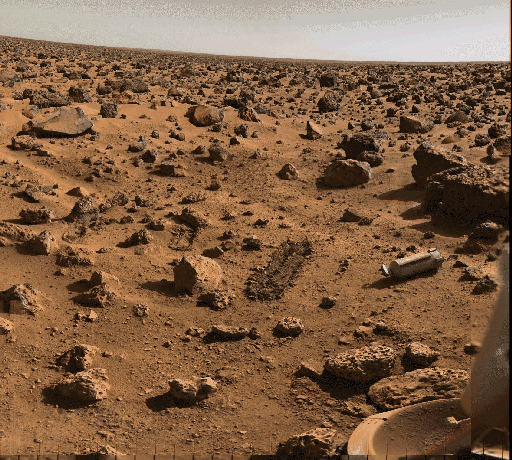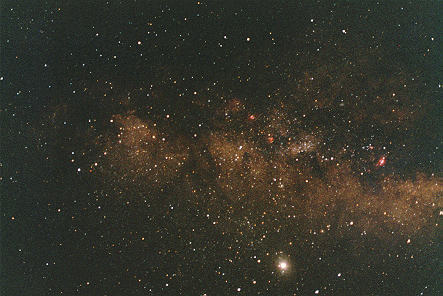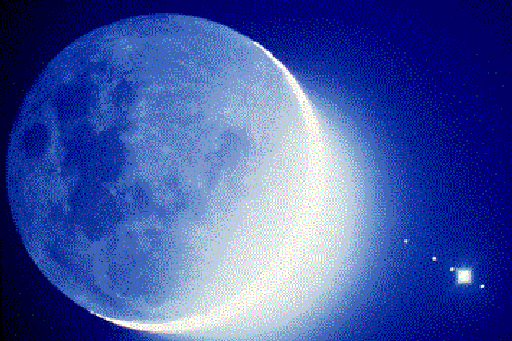NASA APOD #399-408
#399 Tomorrow's picture: July 22, 1996
“The Viking 2 spacecraft was launched on the Road to Utopia in September of 1975 (30 years after Bing, Dotty, and Bob). In August of 1976, after making the second successful Martian landing, Viking 2's lander began recording data used to produce this exquisitely detailed image of the Martian surface in the area of Utopia Planitia (the Plain of Utopia). Visible at the lower right are the protective shroud that covered the lander's soil collector head, ejected after the descent, along with one of the lander's dust covered footpads. Seen near the center are shallow trenches dug by the sampler arm. Mars looks red because its surface is covered with reddish iron oxide dust (rust). This dust, suspended in the thin carbon dioxide atmosphere, also filters the sunlight causing surface views to take on a reddish tinge. The Vikings made the first successful landings on Mars 20 years ago. What does Mars look like today?"
Copyright: Public domain
#400 Tomorrow's picture: July 23, 1996
“Shining brightly, the mighty Jupiter rules this gorgeous Kodacolor photo of the Milky Way near Sagittarius. Astronomer Bill Keel took the picture earlier this month (July 7) while standing near the summit of Hawaii's Mauna Kea contemplating the sky in the direction of the center of the Galaxy (right of picture center). In addition to the gas giant planet, which is well placed for evening viewing, the image contains an impressive sampler of celestial goodies. Many famous emission nebulae are visible as reddish patches - M16, the Eagle nebula, is just above and right of center, with the Horseshoe nebula, M17, just below it and farther to the right. Also, look for the Lagoon Nebula, M8, as the brightest red patch at the right of the picture with the Trifid Nebula, M20, just above it and to the left. The milky glow of distant unresolved stars in the plane of our Galaxy (thus the term Milky Way) runs through the image cut by dark, absorbing, interstellar dust clouds. The much anticipated comet Hale-Bopp is also clearly visible. Where's the comet? Click on the picture to view the comet's location flanked by superposed vertical lines. The comet was discovered while still beyond the orbit of Jupiter a year ago today independently by Alan Hale and Thomas Bopp. Astronomers monitoring Hale-Bopp's activity report that having now brightened to almost 6th magnitude it is still on track for becoming an extremely bright naked-eye comet in early 1997."
Copyright: W. KeelUA
#401 Tomorrow's picture: July 24, 1996
“Diffuse gas clouds laced with radioactive aluminum atoms (Al26) line the plane of our Milky Way Galaxy! How do we see them? Relying on the Compton Effect, the COMPTEL instrument onboard NASA's immense orbiting Compton Gamma Ray Observatory can "see" the 1.8 million electron Volt gamma rays emitted by the radioactive decay. COMPTEL's first ever survey image of the entire sky in the light of gamma rays produced by this exotic radioactivity is shown above. The Galactic plane is horizontal, passing through the Galactic center in the middle of the picture, as indicated by the superposed coordinate grid. The radioactive Al26 clouds are seen to lie in clumps near the plane, with some slightly above and below it. The brightest feature looks like a mysterious inverted "V", just to the left of center. Where do they come from? Al26 decays to magnesium (Mg26) with a half-life of about a million years, a very short time compared to the age of the Galaxy -- so the clouds must have been produced relatively "recently". COMPTEL astronomers are exploring several origins for the radioactive clouds including nuclear processing (nucleosynthesis) by aging massive stars and supernova explosions. Because they are generally thought to be associated with short lived massive stars, the radioactive clouds are expected to be located near sites of recent star formation. (Note added in press: Don't worry - the aluminum atoms in the foil in your kitchen are Al27 and are not radioactive!)"
Copyright: Public domain
#402 Tomorrow's picture: July 25, 1996
“Late March and early April of 1996 marked a banner season for viewing the spectacular naked-eye comet Hyakutake. The spring of 1997 could well offer a similar cometary wonder, Comet Hale-Bopp. Discovered last year while approaching the inner solar sytem Hale-Bopp has been eagerly watched for signs that it will indeed brighten spectacularly. So far, things look good! This recent image of the comet was made on May 14 at the European Southern Observatory when the comet about 340 million miles from Earth. It is shown here using false colors to indicate relative brightness. Stars are visible through the expanding coma. Recent reports are that its level of activity, the rate of dust and gas production from the solar heating of the icy nucleus is as expected. An analysis of its orbit indicates that this comet will approach to within nearly 120 million miles of Earth on March 22, 1997. The orbital calculations also reveal that Hale-Bopp has visited the inner solar system before ... about 4200 years ago."
Copyright: Public domain
#403 Tomorrow's picture: July 26, 1996
“15,000 years ago a star in the constellation of Cygnus exploded -- the shockwave from this supernova explosion is still expanding into interstellar space! The collision of this fast moving wall of gas with a stationary cloud has heated it causing it to glow in visible as well as high energy radiation, producing the nebula known as the Cygnus Loop (NGC 6960/95). The nebula is located about 2500 light years away. The colors used here indicate emission from different kinds of atoms excited by the shock; oxygen-blue, sulfur-red, and hydrogen-green. This picture was taken with the Wide Field and Planetary Camera 2 on board the Hubble Space Telescope."
Copyright: Public domain
#404 Tomorrow's picture: July 27, 1996
“How long would it take to drive to the Sun? Brittany, age 7, and D.J., age 12, ponder this question over dinner one evening. James, also age 7, suggests taking a really fast racing car while Christopher, age 4, eagerly agrees. Jerry, a really old guy who is used to estimating driving time on family trips based on distance divided by speed, offers to do the numbers. "Let's see ... the Sun is 93 million miles away. So, if we drove 93 miles per hour the trip would only take us 1 million hours." How long is 1 million hours? One year is 365 days times 24 hours per day, or 8,760 hours. One hundred years would be 876,000 hours, still a little short of the 1 million hour drive time -- so the Sun is really quite far away. Christopher is not impressed, but as he grows older he will be. You've got to be impressed by something that's 93 million miles away and still hurts your eyes when you look at it!"
Copyright: Public domain
#405 Huck Finn's New Sky View July 28, 1996
“"We had the sky up there, all speckled with stars, and we used to lay on our backs and look up at them, and discuss about whether they was made or only just happened." (from Mark Twain's The Adventures of Huckleberry Finn) Explanation: Even the faintest stars Huck and Jim could see as their raft drifted down the Mississippi were in our own Galaxy. The faintest objects astronomers can see today are the distant galaxies -- entire systems of stars comparable to our own Milky Way, which fill the Universe. Despite the advances, the sense of wonder so simply expressed in Huck's musing is still the same."
Copyright: Public domain
#406 Tomorrow's picture: July 29, 1996
“Approaching the inner Solar System, comet Hale-Bopp's icy nucleus is heated by sunlight, accelerating its production of dust and gas. Shrouded in the resulting cloud, known as the coma, the cometary nucleus remains hidden from direct view. However, astronomers using a 2.2 meter telescope at the European Southern Observatory in May, were able to detect an enormous jet of dust extending northward (up) from the nuclear region as seen in this false color image. Dust jets may arise from vents on the surface of the nucleus. Early estimates of the size of Hale-Bopp's nucleus have indicated that it could be as large as 40 kilometers (24 miles) in diameter -- several times larger than comet Halley's. Hale-Bopp's copious dust production bodes well for it becoming a bright naked-eye comet in the spring of 1997."
Copyright: Public domain
#407 Tomorrow's picture: July 30, 1996
“How often does a Full Moon occur twice in a single month? Exactly once in a Blue Moon. In fact, the modern usage of the term "Blue Moon" refers to the second Full Moon in a single month. Tonight's Blue Moon (Universal Time) will be the first since September 1993. A Blue Moon typically occurs every few years. The reason for the rarity of the Blue Moon is that the 29.53 days between full moons is just slightly shorter than the number of days in the average month. Don't, however, expect the moon to look blue tonight! The term "Blue Moon" is thought to derive from common language expressions used hundreds of years ago. It is possible for the Moon to appear tinged by a blue hue, sometimes caused by fine dirt circulating in the Earth's atmosphere, possibly from a volcanic explosion. The above picture is of our Moon taken was taken in a dark blue morning sky. The bright crescent is the only part directly exposed to sunlight - the rest of the Moon glows from sunlight reflected from the Earth. In this dramatic photo, however, the planet Jupiter is also visible along with its four largest moons."
Copyright: ICSTARS
#408 Tomorrow's picture: July 31, 1996
“Checking out the Galileo spacecraft's cameras during its December 1992 flyby of Earth's Moon, controllers took this dramatically illuminated picture through a violet filter. The view looks down on the Moon's north polar region with the Sun shining from the left at a low angle and the direction toward the moon's North pole toward the lower right. Across the image upper left stretches the smooth volcanic plain of the Mare Imbrium. Pythagoras crater, 65 miles wide, is near the center of the image -- mostly in shadow, its central peak just catches the sunlight. Yesterday, the Moon made its closest approach to Earth and was full for the second time in July (as reckoned by UT dates). The closest point in the Moon's orbit is referred to as Lunar Perigee, a mere 221,797 miles at 8 hours UT. The second full moon in a month is known as a "Blue Moon"."
Copyright: Public domain
Upvote! Resteem! Comment! As you like it! Thank you for attention!










Congratulations @george-zagraid! You have completed some achievement on Steemit and have been rewarded with new badge(s) :
Click on any badge to view your own Board of Honor on SteemitBoard.
For more information about SteemitBoard, click here
If you no longer want to receive notifications, reply to this comment with the word
STOP